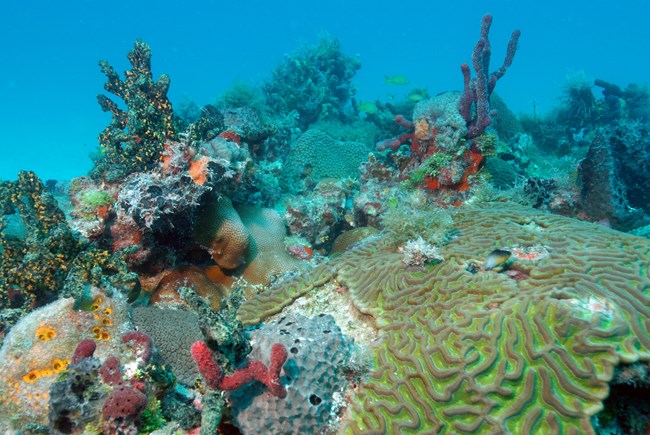
NPS Photo/Rob Waara
Importance/Issues
Coral reef communities consist of stony corals, octocorals, sponges, algae, and gorgonians, among others. These reefs support incredible diversity, including endangered sea turtles, conchs and lobsters. Reefs also play a vital role for humans by supporting fisheries, nursery areas, tourism, pharmaceutical bio-prospecting and shoreline protection to name a few. Monitoring coral reefs was identified as a national priority in President Clinton's Executive Order 13089, establishing the Coral Reef Initiative. These coral reefs are negatively impacted by unusually high water temperatures that cause "bleaching," coral disease, vessel scarring, major storms, and in some cases by sedimentation and nutrient enrichment.Coral reefs within the South Florida/Caribbean Network represent some of the best examples of Caribbean and Western Atlantic coral reefs within the National Park Service. The enabling legislation that created the parks and/or presidential proclamations for Virgin Islands National Park (VIIS), Buck Island Reef National Monument (BUIS), and Dry Tortugas National Park (DRTO) specifically mention coral reefs within these park units as significant environmental communities.
Monitoring Objectives
- Determine whether percent cover of major taxonomic groups (e.g. coral, algae [turf, calcareous, macroalgae], gorgonians, sponge, substrate), coral species diversity, coral community structure, and rugosity are changing through time within selected coral reef sites
- Determine how the above mentioned response variables vary in space within park reefs and how these variables, which describe coral reef health, are changing throughout time within different management zones.
- Track trends and severity in reef-associated covariates such as coral bleaching, coral disease and presence of the herbivorous sea urchin, Diadema antillarum.
- Maintain and archive a video record of the transects to allow for quantification and future analyses of benthic components not identified in this protocol.
Approach
The parks within the South Florida/Caribbean Inventory and Monitoring Network have some of the longest continuous monitoring programs within the Caribbean, and the world, for marine systems, with some annual surveys with more than two decades of data. Annual monitoring began at Yawzi (1988) and Newfound (1989) Reefs at Virgin Islands National Park (VIIS) using the linear chain transect method to evaluate composition and changes in benthic community. Development of the Videography and Aquamap protocols that are currently in use by network scientists began under the United States Geological Survey (USGS)/ National Park Service (NPS) prototype program in 1997.The videography method uses 10-meter transects which are filmed annually with a digital video camera in underwater housing. Each transect videotape is broken into frames and 10 dots randomly identified per frame for a total of about 300-350 dots identified to coral species and other benthic community type per transect. Percent cover of living coral by species, macroalgae, turf algae, crustose coralline algae, octocorals, and sponges are calculated. Data on coral disease, bleaching, water temperature, and long-spined sea urchins are also collected. Two different approaches are used for sampling: 1) if an area of interest is relatively small, i.e. less than 50,000 sq. meters, 20 transects are randomly placed within the site. If an area of interest is much larger, then multiple 4-transect sites are randomly placed within the larger area. The network has been annually monitoring coral reef sites using videography at: Virgin Islands National Park (VIIS) since 1999, at Buck Island Reef National Monument (BUIS) since 2000, at Dry Tortugas National Park (DRTO) since 2004, at Biscayne National Park (BISC) since 2004, and at Salt River Bay National Historical Park and Ecological Preserve (SARI) since 2012.
Coral Reef publications
FInd all monitoring reports, protocols, and resource briefs below.Source: NPS DataStore Saved Search 3787. To search for additional information, visit the NPS DataStore.
Source: NPS DataStore Collection 2607. To search for additional information, visit the NPS DataStore.
Source: NPS DataStore Saved Search 2337. To search for additional information, visit the NPS DataStore.
Source: NPS DataStore Saved Search 2367. To search for additional information, visit the NPS DataStore.
Source: NPS DataStore Saved Search 2339. To search for additional information, visit the NPS DataStore.
Source: NPS DataStore Saved Search 1255. To search for additional information, visit the NPS DataStore.
Last updated: March 30, 2021
